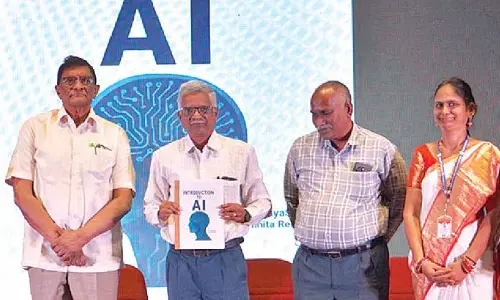Can AI Catch AI? Exploring Tools Like AHelp’s AI Detector
Share :

Artificial intelligence tools are becoming increasingly prevalent in content creation, from writing essays to generating marketing copy. While these tools are valuable, they also present challenges, especially for educators, businesses, and content reviewers who need to ensure originality and detect AI writing. But can AI identify AI-generated content effectively?
AI detectors are the latest tools in the fight to maintain integrity in academic and professional content. This blog dives into the effectiveness of using a free AI detector and the future potential of AI writing detection technologies.
AI Content Detector: Understanding the Technology Behind Detection
AI content detectors are designed to distinguish between human-written text and AI-generated text. By analyzing patterns, syntax, phrasing, and vocabulary usage, these tools use machine learning models to flag content that appears “machine-like.” Models like GPT-3, GPT-4, and others often leave traces of predictability in text generation, which AI detectors aim to identify.
Best AI Detector Tools on the Market
While there are several options available, the following have stood out as reliable tools for AI writing detection:
1. AHelp AI Detector: Known for its user-friendly interface and reliability, AHelp caters to educators and professionals looking for accuracy.
2. GPTZero: Popular with educators, this tool flags AI-generated content using its deep language model analysis.
3. Originality.ai: Often used by marketers and publishers, Originality.ai detects AI writing and checks for plagiarism in one go.
4. OpenAI Detector: The creators of GPT models also offer a detection tool, specifically tuned to identify their generated content.
5. CopyLeaks AI Content Detector: Favored for its detailed analysis and compatibility with multiple sectors, including academia and marketing.
Each of these tools has its own strengths and target audiences, but which truly excels in AI plagiarism detection?
How to Catch AI Writing in Student Work
For educators and academic institutions, the rise in AI-generated essays and assignments has necessitated actionable strategies. Here’s how AI writing detection tools, like AHelp, can assist:
● Red Flags in Style: AI models sometimes produce highly structured yet overly monotonous work. Detectors highlight these suspicious patterns.
● Tense and Syntax Analysis: AI-generated writing may exhibit repeated sentence structures or lack the nuanced, human-like adjustments across paragraphs.
● Batch Scanning for Workload Efficiency: AI detectors, like AHelp, enable educators to upload and scan large volumes of documents. This speeds up the process of reviewing submissions while increasing accuracy.
An important point is to pair AI detection with human judgment. If flagged, educators should engage students to confirm or refute the findings based on context and clarification.
AHelp AI Detector: A Closer Look at Its Capabilities
AHelp positions itself as a top-tier AI content detection tool for professionals and educators. But how does it distinguish itself from other platforms?
AI Text Detector Accuracy and Reliability
AHelp’s AI detector leverages extensive training on both human-written and machine-generated content datasets. This dual training allows it to analyze subtle cues, detect AI plagiarism, and provide detailed assessments. Key highlights include:
● High Sensitivity: It can flag content created by different versions of generative AI, such as GPT-3, GPT-3.5, and GPT-4, making it adaptable to evolving capabilities.
● Low False Positives: Through rigorous refinement, AHelp minimizes instances of wrongly labeling human-written work as AI-generated, a common shortfall of many detection tools.
● Multi-Language Support: Unlike some platforms, AHelp can assess text across multiple languages, ensuring versatility for global users.
User reviews often rate AHelp higher than competitors for its reliability and consistent performance.
How to Catch AI Writing Using AHelp’s Features
Apart from detection accuracy, AHelp offers specific features tailored to simplify the process for educators and businesses:
1. Detailed Reports: AHelp provides breakdowns on detected AI text, highlighting flagged sections and explaining the rationale for its findings.
2. User-Focused Dashboard: The easy-to-navigate interface lets users upload, assess, and review text seamlessly across various formats.
3. Customizable Scanning Options: Users can fine-tune the tool to emphasize certain aspects, such as originality scores or AI detection thresholds.
4. Integration Tools: AHelp supports API integration, allowing seamless incorporation into learning management systems (LMS) or company software.
By combining these features, AHelp not only detects but also educates users on AI writing trends.
AI Detection Tools: The Future of Academic Integrity
AI content detectors have significant implications for academic integrity, company workflows, and even content publishing standards. However, challenges and opportunities lie ahead as these tools evolve.
Comparing the Best AI Detector Tools for Educators
For educators seeking reliable tools, a comparison between available platforms is vital. Here’s what the market leaders offer, including the AHelp AI content detector review:
Educators focused on efficiency, reliability, and actionable insights may find AHelp to be the best AI plagiarism checker for their institution.
Evaluating AI Text Detector Accuracy Across Platforms
The long-term viability of AI detection heavily depends on accuracy against increasingly sophisticated AI-generated content. Future advancements in generative AI models could blur the lines between AI and human writing even further. Detection technologies like AHelp are geared to adapt by:
● Continuously updating their data training models to match newer AI developments.
● Developing predictive detection to anticipate how AI writing evolves.
● Engaging in partnerships with educators and writers to collaboratively address issues like plagiarism.
With these improvements, AI writing detection tools are poised to become even more central to maintaining trust and credibility in content creation.
Safeguarding Integrity with Tools Like AHelp AI Detector
The rise of AI brings opportunities but also challenges for educators, business professionals, and writers. Detecting AI-generated content is not just about catching plagiarism or flagging unoriginal text; it’s about maintaining ethical standards and fostering transparency in writing.
AHelp’s AI content detector stands out in this rapidly growing field, offering a user-friendly interface, accurate detection capabilities, and insightful reporting. Whether you’re an educator striving to uphold academic integrity or a professional ensuring authentic marketing content, AHelp has the tools to support you.
Take the Next Step
Explore how AHelp can revolutionize your approach to content review. Sign up today for a free trial and experience the difference it can make in detecting and managing AI writing effectively.


















